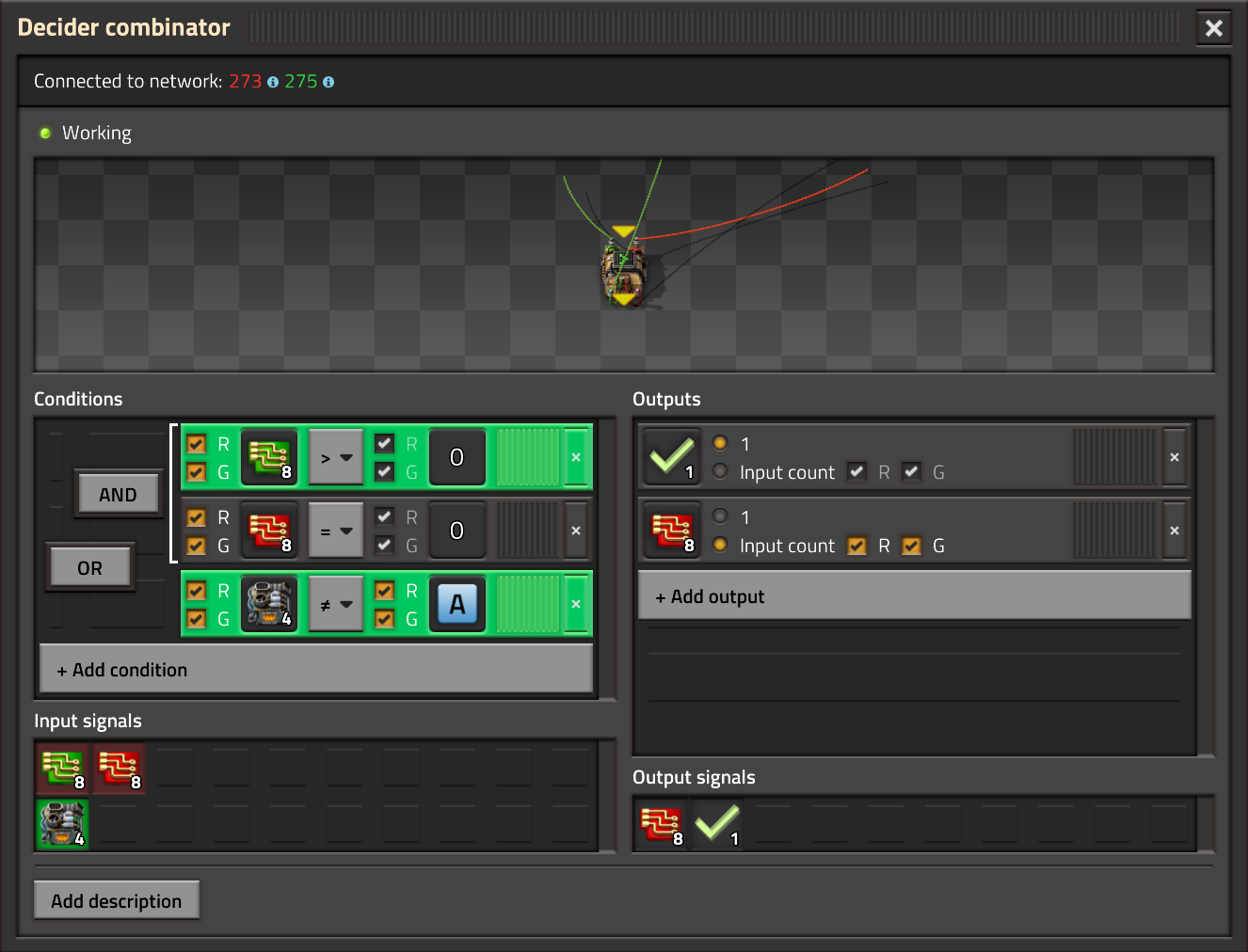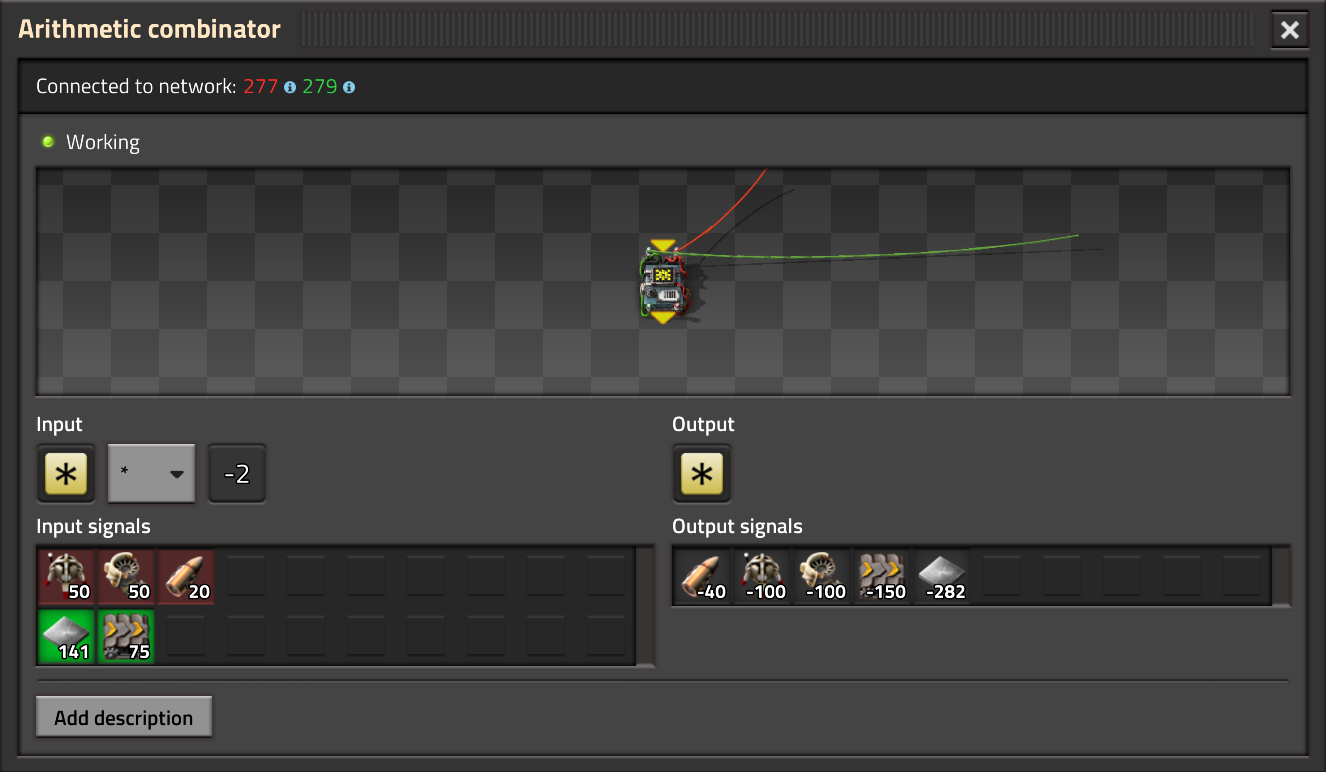JohnyDL wrote: Fri Nov 17, 2023 9:05 am
I'm with Qon you're asking for a combinator to perform two completely different bits of logic and have two completely different outputs on each wire
That is not true.
Just look at graphic shown in FFF

.
Conditions are on the left side top.
Outputs are on the right side.
Now Imagine to have behind each output two check-boxes: "to red" and "to green", booth of them checked by default.
No more.
JohnyDL wrote: Fri Nov 17, 2023 9:05 am
I'm going to go through every variation I can think of and build up to why I believe Qon is arguing against this idea.
Thank you for that ..
JohnyDL wrote: Fri Nov 17, 2023 9:05 am
In the simplest case if you're asking Green to output something when the logic is true and Red to output something else when the logic is false
No I do not ask for that, because there is only one set of conditions which could either be TRUE ore FALSE but not booth.
JohnyDL wrote: Fri Nov 17, 2023 9:05 am
However, it feels like what you're asking for is different results on each wire with different logic leading to each wire not simply inverted logic,
No - Just different outputs to different channels if ONE set of conditions is TRUE.
For special outputs in Case of FALSE you need indeed a second combinator.
JohnyDL wrote: Fri Nov 17, 2023 9:05 am
The biggest issue I see comes when you're copying and pasting the value of a dual combinator from one build into another (because we're lazy people and copy-paste is easier than setting up a huge complex array of logic a second time) you run into problems, maybe because of something else going on in the new circuit you have/need the red and green output wires swapped compared to the donating circuit. A newbie might copy and paste expecting the same functionality from a dual combinator but might get something broken half the time... with the proposed decider combinators having dozens or hundreds of conditions with AND and OR logic between them (if not other operators like XOR and NAND as requested on the thread) a newbie or even an experienced person might not be able to tell at a glance if the 'broken circuit' is because some set of signals in among the 100s of settings that were copied and pasted is doing things not quite intended or if the two outputs of a dual combinator were relatively swapped, and most people are going to look at the logic first not to check if the outputs are in the right places.
That is for me (as non English native) hard to understand.
If I read it right you don't like the feature because of someone might copy it in a place where it doesn't fit?
That's true for everything else: If you copy a combinator set up for copper in a place where it should control iron, it won't work.
And the rest of the problem might depend of you imagination of a dual combinator what's I already have stated wasn't my intention.
JohnyDL wrote: Fri Nov 17, 2023 9:05 am
I agree with you that the FFF is suggesting compressing the logic of several combinators into one and compressing several combinators doing the exact same logic into one. This is not really equivalent to what you're asking for.
I just asked for directing outputs

JohnyDL wrote: Fri Nov 17, 2023 9:05 am
But what Qon is arguing I believe (and what I'm saying for certain) is that by implementing your suggestion you make them a more powerful tool but also a much more complicated one to learn and use. You're adding 1 more setting that feels small and only impacts how the combinator behaves in a tiny way but you're in effect multiplying the possible problems each combinator can cause within any system by at minimum 4, for every "is my logic wrong" step you also have to ask "am I outputting the right things onto the correct wire(s)" which has 4 answers (for each output in the combinator -> Red, Green, Both, Neither [which you can use for internal debugging]). Right now all the outputs of all places that have outputs are 'tied together' whatever is being output is being put onto all connected wires, this is true on belts, boxes, inserters as well as combinators.
Yes I agree with you, that it comes to 4 possible "is my logic wrong"-cases. But this will allways happen if you need two different outputs.
Imagine you have NOT done it the way I suggest.
What you need to do is to build two different combinators for each channel.
Every time you have to change or tune something on the conditions, you
need to remember to do the exact thing in
booth combinators.
If you (or someone else on MP) has change a setting only in one combinator and forgot in the other one, it could get very complicated.
Due to the fact that devs are already on the way to add more complex logic to "conditions" you would be happy to check if combinator outputting to red has
exactly the same conditions a the combinator outputting to green.
So you need to swap between those two combinators GUIs to compare. Or you copy-paste settings and reconfigure the output (because that is what is different).
JohnyDL wrote: Fri Nov 17, 2023 9:05 am
Having two separate combinators doing similar very complex logic might be annoying given how powerful the new combinators appear to be, but it's also easier to understand and debug especially as you get into playing with more complicated combinator systems... Yes, you're still going to have to debug but you won't have to debug both the logic and the outputs in concert with one another...
Its easier to debug booth logic and output as to debug two complex logics in having no differences.
JohnyDL wrote: Fri Nov 17, 2023 9:05 am
And this comes from someone who has asked for Arithmetic combinators to do "multiple things" in this thread. I'd like for Arithmetic combinators to do the logic
A*X => Q, A*Y => P, A*Z => R... I could set up several combinators to do them separately I totally agree, but the combinator is providing the same logic on the left side (in my opinion) and the right side outputs are put onto all wires.... why do I say A*X the same logic as A*Y? well if we say A is blue science signal and X, Y, and Z are constants for how many red circuits, Engines and Sulphur are in each blue science, the logic is "calculate the components necessary to make the inputs", and while I would like this (and it has many other applications) I don't necessarily need it, and while it is 'more complex logic' and 'combining combinators' when anyone copies these setting from one place to another it's still going to work exactly the same in the new location regardless of which wires any player chooses to connect, the logic might still be wrong but it's all going to be wrong in the same place(s) as if it were expanded. My suggestion has limitations too as whatever A and the operator are they must always be the same things for all equations in that arithmetic combinator, you can't do 2 completely different operations like A * X and B + Y, I think this is right in line with how the proposed Decider works, after all from the expanded way I explained above it does that same math of True * {selected outputs} which is so close to A * {selected Variables}
That is again hard to read for me.
But as far as I see, you will able to do that with new combinators. Because on the left side you will have equations to perform if conditions are true.
An there are multiple lines which implies that multiple equations are welcome.
The only thing whats currently not available is to select the direction of output - whats my suggestion.
 .
.
